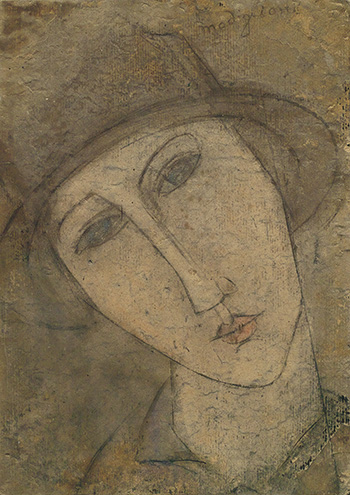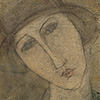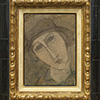PROVENANCE:
Collection of Madame L. Charpentier from 1919-1937, Paris (acquired directly from the artist)
Madame Ribas, Emilio Ribas from 1937-app. 1966, Barcelona
Welters van Hattum, Dutch collection, Vice Consul of the Netherlands from app.1968
Private collection, Europe (from the late 1970s till now)
EXHIBITED:
Works by Amedeo Modigliani in Dutch Possession , Centraal Museum Utrecht, Netherlands, March 15-May 5, 1968
ILLUSTRATED:
Works by Amedeo Modigliani in Dutch Possession , Centraal Museum Utrecht, Netherlands, 1968, no. 2, pp. 12-13
Collection Welters van Hattum, Netherlands, no. 2
This work is to be sold with a certificate of authenticity signed by Arthur S. Pfannstiel, the expert for Modigliani’s art in 1966.
Catalogue Note:
The romance between Amedeo Modigliani and his muse Jeanne Hébuterne (1898 - 1920) has been told by so many people, it had already turned into a beautiful legend in a chapter of history. While people admired the portraits of women by Modigliani, the sounds of admiration are always accompanied by sighs of melancholy. They feel sorrow and regret at the gods' envy of this young talent and the resultant tragedy that has lived on in people's hearts. Paris in the beginning of the twentieth century was a celebration of life, the couple symbolized freedom and lack of inhibitions, as well as the carefree abandon of creativity and talent. This was the most memorable of periods in art history.
In the spring of 1917, the sculptor Chana Orloff introduced this debonair and charming prince of Montparnasse, Modigliani, to Jeanne. She was a nineteen year-old art student from a conservative Roman Catholic bourgeois family. Her parents had supported and cultivated her artistic talents from a young age. According to the descriptions of writer Charles-Albert Cingria and photos, Jeanne was an elegant, shy, and quiet girl whose determination and firm personality shone from her eyes. It's not difficult to imagine that later on she would give up all for love and leave her parents and family behind.
With art movements developing and flourishing, when compared to the conservativeness of traditional art academies, young students thirsting for knowledge believed that there would be more opportunities and room for creativity at the gover nment-supported art schools. Jeanne entered the Académie Colarossi which was located on 10 rue de la Grande-Chaumière. The school was coed and accepted students from all over the world. It provided full training under the academy-system and it also permitted female students have nude male models for sketching and had a forwardthinking and open-minded environment. Some of its students include Rodin's disciple, Camille Claudel and Modigliani himself.
Jeanne adored the artist and found the bohemian lifestyle mesmerizing, although she did not have the support or blessing of her family, she insisted on moving-in together with Modigliani. Ever since they met each other, these two passionate hearts had not been easily separated. Modigliani left his partner, the female artist Beatrice Hastings and Jeanne became the exclusive model and muse of inspiration of Modigliani. In December of the same year, the artist's good friend and art dealer, the Polish poet Léopold Zborowski, organized at the Galerie Berthe Weill, Modigliani's first and only solo exhibition. Only one painting was sold at the exhibition, four hours after the opening, in a dramatic turn of events, the exhibition was banned by the Paris police on the grounds that the nude female figures in the paintings were too provocative and disrupted public order.
Modigliani went back to his former lifestyle of wandering from coffee shops and bars, but in the company of Jeanne and with the financial support of his art dealer friend, he reached the pinnacle of his artistic creativity. Numerous masterpieces were completed during this period. In 1918, in the midst of the heated battles of WWI, Modigliani's health continued to deteriorate. Therefore, his agent Léopold Zborowski organized for the couple and the artists Soutine, Léonard Tsugouharu Foujita (Lot 102, p. 14) to go south to Nice on the Côte d'Azur (French Riviera). It was hoped that many of the wealthy collectors who winter there would be able to raise the sales volume for Modigliani.
But in reality, even though Modigliani completed many important works in southern France, he still had significant financial pressures and he was forced to sell his works for a meager price. This could especially been seen in a letter that he wrote to Léopold Zborowski, when his wallet and documents got pick-pocketed, it added even more strain to the life of the couple. In June of 1916, the couple left the south with their new-born daughter and first child to return to Paris, and moved into a small apartment on no. 8 rue de la Grande-Chaumière.
On January 24, 1920, Modigliani died from meningitis, Jeanne was completely overwhelmed and desolate, also at the time, she was already nine-months pregnant. She agreed to return to her parents' home but two days later, she jumped from a fifth-floor balcony and followed her lover into eternity. Struck down by Death at the moment of glory and Devoted companion to the extreme sacrifice. These two epitaphs had been laid down in remembrance of the two lovers who had given their life for love and art.
This auction piece, Woman in Hat (Jeanne Hébuterne) has been authenticated by the expert, Arthur S.Pfannstiel, as a work produced between 1917 to 1918; it is an oil, pastel, and charcoal on cardboard. The woman is wearing a felt hat, she has a delicate face with a slender neck, a pair of blue eyes and smiling r ed lips. All of it ar e subjects that the public admired about the artist. The subject in the painting seems to gaze at the viewer's soul, this also serves as testament to the inspiration that Modigliani found which was cr eated by the collision of Paris avant-garde and classical Italian traditions.
This artwork is from the collection of the Spanish Ribas-Vila family, their family member Mme Vve. Ribas-V ila was friends with Modigliani's neighbor Mlle. Charpentier, when they lived at no. 8 rue de la Grande- Chaumière. Mlle. Charpentier was a friend of the artist, she had often visited him and provided financial assistance when he was alive. In the property of Mlle. Charpentier, there was a set of artworks given to her by the artist himself. In 1968, Vice Consul of the Netherlands Welters Van Hattum, bought this set of artworks and became a collector with one of the biggest collection of Modigliani works in Europe at the time. Later, the collection was exhibited at the Centraal Museum in Utrecht, Netherlands and it had caused quite a stir at the time.


